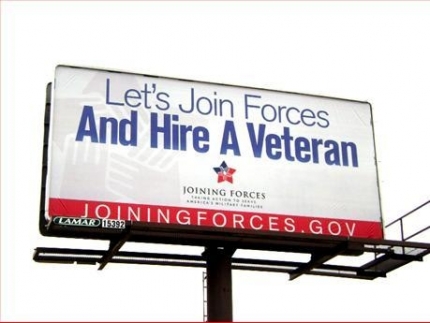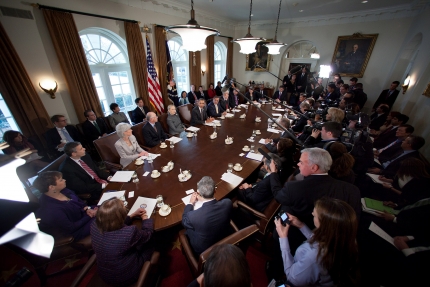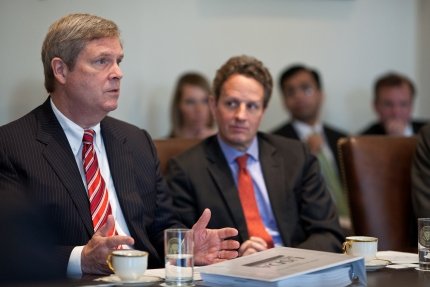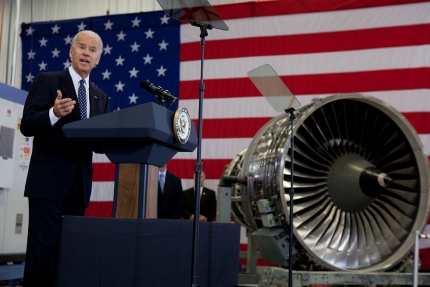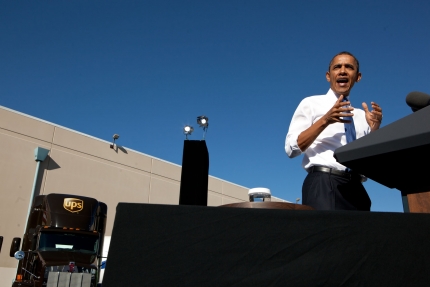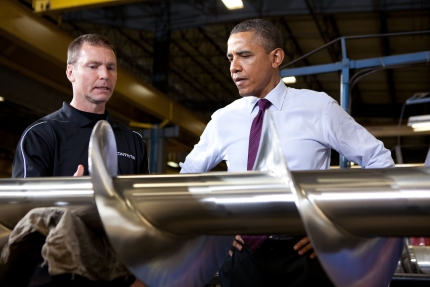Jobs News
President Obama's Plan to Train 2 Million Workers for Jobs in High-Demand Industries
Posted by on February 13, 2012 at 5:26 PM EDT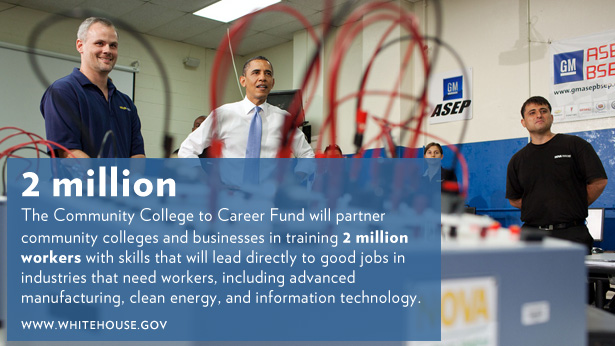
Today, President Obama announced the Community College to Career Fund, an $8 billion investment in his Fiscal Year 2013 Budget that would train two million workers with skills that lead directly to good jobs in industries that need workers, including advanced manufacturing, clean energy, and information technology.
This program will serve a dual purpose: making sure community colleges have the resources they need to equip workers with crucial skills and industry-recognized credentials, and ensuring that employers in high-growth industries have the skilled workforce they need for positions that might otherwise go unfilled—or overseas.
Employers today are looking for skilled, educated workers, and they should be able to find those workers right here in the United States. Here’s how the Community College to Career Fund would help:
Support for workers:
In addition to supporting community college-based training programs that provide workers with targeted, certified training for jobs in rapidly growing industries like clean energy, high-tech manufacturing and information technology, the proposed program will fund:
- On-the-job training opportunities such as registered apprenticeships and paid internships that allow students to simultaneously earn credit for work-based learning and gain relevant employment experience in high-wage, high-skill fields.
- “Pay for Performance” strategies that provide incentives for training providers, community colleges, and local workforce organizations to make sure workers find permanent jobs after they complete training and earn credentials.
Learn more about EconomyJoining Forces to Hire America’s Veterans – Idaho Style
Posted by on February 13, 2012 at 12:31 PM EDTDriving down the interstate in Idaho, you may be surprised by the new billboards you pass. Instead of being greeted by ads for fast-food restaurants and chain hotels, billboards that encourage the hiring of veterans grace the sides of the road.
“Let’s Join Forces And Hire A Veteran,” the signs proclaim. This call to action comes from Lamar Advertising, a Boise-based billboard company that has put up 32 billboards in Idaho to get the word out about hiring our nation’s veterans. These huge billboards encourage Americans to view veterans as assets and to give them the chance to demonstrate their skills and talents through meaningful employment.
Lamar has teamed with Joining Forces in this public service campaign. Efforts like Lamar’s are helping to answer the President’s call to hire and/or train 100,000 veterans or their spouses by the end of 2013, a goal which we are moving closer toward every day.
This donation from Lamar Advertising is exactly what the First Lady had in mind when she launched Joining Forces with Dr. Jill Biden, asking every American to do what they do best in support of our veterans and their families. Lamar is taking on that challenge. A leading advertising firm that specializes in billboard ads, Lamar is making a difference in Idaho by raising awareness of veteran unemployment. This awareness will ultimately lead to jobs for men and women who have taken an oath to protect and defend our country. Today, only 1 percent of Americans serve our nation as military members, taking care of the other 99 percent of citizens. With companies like Lamar, we are supporting those who support us.
The Employment Situation in January
Posted by on February 3, 2012 at 10:31 AM EDTToday’s employment report provides further evidence that the economy is continuing to heal from the worst economic downturn since the Great Depression. It is critical that we continue the economic policies that are helping us to dig our way out of the deep hole that was caused by the recession that began at the end of 2007. Most importantly, we need to extend the payroll tax cut and continue to provide emergency unemployment benefits through the end of this year, and take the additional steps that President Obama proposed in his State of the Union address to create an economy built to last.
The unemployment rate fell 0.2 percentage point to 8.3%, from a high of 10% in October 2009. The drop in unemployment over the month was entirely due to employment growth, as the labor force participation rate remained constant, once new population weights are taken into account. The unemployment rate has fallen by 0.8 percentage point in the last 12 months. Private sector payrolls increased by 257,000 jobs and overall payroll employment rose by 243,000 jobs in January. Despite adverse shocks that have created headwinds for economic growth, the economy has added private sector jobs for 23 straight months, for a total of 3.7 million payroll jobs over that period. In the last 12 months, 2.2 million private sector jobs were added on net. Nonetheless, we need faster growth to put more Americans back to work.
Sectors with net job increases in December included professional and business services (+70,000), manufacturing (+50,000), leisure and hospitality (+44,000), health care and social assistance (+29,700), and construction (+21,000). Government lost 14,000 jobs.
The monthly employment and unemployment numbers can be volatile, and employment estimates can be subject to substantial revision. Therefore, as the Administration always stresses, it is important not to read too much into any one monthly report; nevertheless, the trend in job market indicators over recent months is an encouraging sign.
Learn more about EconomyIn the Showroom of the Washington Auto Show
Posted by on January 31, 2012 at 7:30 PM EDTThis afternoon, President Obama made the trip across town to the Washington Auto Show to look at some of the incredible new vehicles being built by Detroit.
There, he told reporters:
Let me just say, when you look at all these cars, it is testimony to the outstanding work that's been done by workers -- American workers, American designers. The U.S. auto industry is back. The fact that GM is back, number one, I think shows the kind of turnaround that's possible when it comes to American manufacturing.
Check out the video.
Learn more about EconomyA Legislative Agenda to Startup America
Posted by on January 31, 2012 at 6:36 PM EDTToday, Startup America celebrates its first birthday, and President Obama is sending Congress a set of proposals to help boost the startups and small businesses that create so many jobs in this country.
President Obama has already cut taxes for businesses 17 times. Now, he's asking lawmakers to create four new tax cuts. He's proposing a new 10 percent income tax credit on new payroll for small businesses; a permanent extension of a tax cut he signed in 2010 that eliminates taxes on capital gains in key investments for small businesses; a doubling of the amount that entrepreneurs can deduct from their taxes for start-up expenses, and a 100 percent extension of first-year depreciation of qualified property for one year.
To help businesses find more investors, the President is calling for a national framework that allows entrepreneurs to raise money through "crowdfunding." Currently, the most a small business can raise through a round of "Regulation A" mini-funding is $5 million -- but President Obama wants to boost that limit to $50 million, coupled with strong protections for investors. He's calling for changes in how securities laws and regulations are phased in for small companies in their first year after going public. And the President wants to increase the Small Business Investment Company program to to allow for up to $4 billion in annual support.
President Obama is also calling on Congress to relieve the backlog of immigrant visas. To do that, he wants lawmakers to eliminate the country-specific caps for certain immigrant visas to attract more high skilled foreign workers, particularly entrepreneurs.
To learn more about all these proposals, go here.
Learn more about Economy, Startup AmericaA Cabinet Meeting Focused on Small Business
Posted by on January 31, 2012 at 4:58 PM EDTToday, President Obama convened a meeting of his Cabinet to discuss the ideas he laid out in the State of the Union. Joining the meeting was a new member of that Cabinet -- Karen Mills, the head of the Small Business Administration.
The President elevated Mills to ensure that entrepreneurs always have a direct line to the Oval Office. He said:
I mentioned at the State of the Union that there have been discussions, bipartisan discussions between Republicans and Democrats, about a whole set of measures that can accelerate financing to startup companies; can provide tax breaks to startups and small businesses that are interested in either hiring more workers or increasing their wages; that looks at innovative ways for them to raise capital.
And my expectation and hope is, is that they will get a bill together quickly, that they will pass it and get it on my desk. I will sign it right away, and I would like to see that bill signed this year.
The President also ran through what agencies like the Departments of Commerce, Energy, and Education are doing to help American businesses as well. He said:
[What] we want to do is to make sure that every single agency, even as they’re tending to their energy initiatives or providing homeland security or transportation or defense, that we’re also thinking about how are we advancing the cause of giving small businesses and entrepreneurs opportunities to start creating the next Google or the next Apple or the next innovative company that’s going to create jobs and improve our economy.
Read the full remarks.
Learn more
- Watch the 2012 Enhanced State of the Union
- Everything you need to know about the President's Blueprint for American Manufacturing
Learn more about EconomyCelebrating Startups in the State of the Union
Posted by on January 31, 2012 at 9:00 AM EDTEd note: In honor of the one year anniversary of Startup America, we invited Mike Krieger, the co-founder of Instagram, to contribute a post to WhiteHouse.gov. Instagram is the fastest growing social mobile startup in the U.S. today, and exemplifies President Obama's belief that "entrepreneurs embody the promise of America: the idea that if you have a good idea and are willing to work hard and see it through, you can succeed in this country. And in fulfilling this promise, entrepreneurs also play a critical role in expanding our economy and creating jobs." Mr. Krieger moved from Brazil to California to attend Stanford University, where he studied computer science and cognitive science. In 2010, he and a partner founded Instagram, which now employs a talented, growing team of designers and engineers. After graduation, Mr. Krieger worked for a year on his student F-1 visa, later applying for and receiving an H-1B visa as a high-skill worker. Mr. Krieger wants to permanently stay in the U.S. and has applied for a green card.
I was born in Sao Paulo, Brazil, and from an early age was interested in technology and engineering. When I came to the United States in 2004 to attend university at Stanford, I was instantly inspired by the stories and advice from startup leaders in Silicon Valley and beyond, who had endeavoured to create new opportunities and improve lives around the world. I was drawn to the idea of one day helping to create a startup, and last year, I was fortunate to be given the chance. In May of 2010, I joined Kevin Systrom, my co-founder, and we created Instagram, a mobile social network that today has over 15 million users. What began as a small, two-person startup working out of a pier in San Francisco has grown to a dozen employees, and our plan is to at least double that this year. There are few better sights than walking into an office full of talented, hard-working folks, working together to build a great company from the ground up.
Weekly Address: President’s Blueprint Includes Renewal of American Values
Posted by on January 28, 2012 at 6:45 AM EDTIn his weekly address, President Obama discusses the blueprint he put forward this week in the State of the Union Address for creating an economy built to last. After focusing on American manufacturing, American energy, and skills for American workers during each of the last three days, he used his weekly address to highlight his commitment to a renewal of American values. The President is challenging leaders in Washington, DC to follow the model set by our men and women in the military, end the gridlock and start tackling the issues that matter – without regard for personal ambition.
Transcript | Download mp4 | Download mp3
Learn more
- Watch the enhanced version of the 2012 State of the Union Address
- Read President Obama's Blueprint for an America Built to Last
- Take a deep dive into the data behind the President’s plan
- Find out how you can talk to Obama Administration officials about the President's plan
- Everything you need to know about President Obama's Blueprint for American-made energy
- Everything you need to know about President Obama's Blueprint for manufacturing
Secretary Shinseki to the Private Sector: Hire our Veterans
Posted by on January 27, 2012 at 7:58 PM EDTEd note: This was originally posted on the VA's blog, VAntage
This week, VA Secretary Eric Shinseki met with National Franchise business leaders in Atlanta to promote Veteran employment. The effort was the part of the Obama Administration’s Joining Forces Initiative, which aims for a simple yet important goal: To connect our Veterans and their families with meaningful employment.
Secretary Shinseki talked about a win for everyone involved; a win for employers that receive great, disciplined, and hardworking employees and Veterans, who have the ability to achieve their goals out of uniform.
It’s all part of a plan to support Veterans, as the President said in the State of the Union, “so that America is as strong as those who defend her.”
The International Franchise Association has pledged to hire and recruit 75,000 Veterans and their spouses by 2014. With the example they set, I hope it’s a trend that continues across America.
Secretary Shinseki has made a strong case for Veterans in the workplace. “They make exceptional employees and business leaders,” he told the collection of business leaders in Atlanta. “Let’s hire them. Let’s find them work.”
Weekly Wrap Up: An America Built to Last
Posted by on January 27, 2012 at 7:08 PM EDTA quick look at what happened this week on WhiteHouse.gov:
State of the Union: In his third State of the Union Address on Tuesday, the President outlined his vision for “an America that lasts”—one that will bring about a new era of American manufacturing, and promote homegrown and alternative energy sources—and presented a blueprint to achieve that vision. Check out this video that goes behind the scenes as President Obama prepared the speech.
Blueprint for Manufacturing: During his visit to New Hampshire following Tuesday’s State of the Union address, Vice President Biden highlighted the Administration’s plan to help businesses bring jobs back to America through manufacturing. He echoed the President’s message that we need to commit to train workers with the skills they will need to compete in the growing sectors of our economy.
Talking Energy in Las Vegas: From a UPS facility in Las Vegas, the President spoke about the future of American-made energy. “[Even] with all this oil production, we only have about 2 percent of the world’s oil reserves,” the President said, “So we've got to have an all-out, all-in, all-of-the-above strategy that develops every source of American energy—a strategy that is cleaner and cheaper and full of new jobs.”
#WHchat: Throughout the week, more than thirty administration officials have answered questions about President Obama’s State of the Union Address and issues Americans care about through a series of Office Hours on Twitter—addressing queries about everything from the economy to disability policy. Vice President Biden—known in the twitterverse as @VP—answered questions submitted by people across the country in his first-ever Twitter interview from an advanced manufacturing facility in Rochester, New Hampshire.
NHL Champs: On Monday, the President welcomed the Boston Bruins to the White House and congratulated them on their Stanley Cup victory in June—marking the team’s sixth Cup championship, and their first one in nearly forty years. Their triumph, the President said, “proved that teamwork is everything.” After their visit to the White House, the players led a hockey clinic—affirming that being a champion doesn’t end when you hang up your skates.
Learn more about Economy, Innovations, Education, Energy and Environment, Veterans, Additional IssuesVice President Biden: "America Is Coming Back"
Posted by on January 27, 2012 at 3:32 PM EDTYesterday, Vice President Biden visited Rochester, New Hampshire to highlight the Administration’s plan to help businesses bring manufacturing jobs back to America. He made one central message clear: “America is coming back.”
As the Vice President emphasized, the policies the Obama Administration has put in place in its first three years are beginning to pay off—especially in manufacturing. The economy added 334,000 manufacturing jobs in the last two years, making it the strongest period of manufacturing job growth since the late 1990s. And now, instead of hearing about outsourcing, we’re finally starting to hear about insourcing as more and more companies realize that it makes real business sense to bring jobs back to America.
Manufacturers are coming back because, while costs in China are rising rapidly, “American workers are the most productive workers in the world,” the Vice President said. And to reinforce that advantage, we need more partnerships between businesses and community colleges to train workers with the specialized skills employers need.
Vice President Biden had the opportunity to see such a partnership in action in New Hampshire yesterday—a partnership that is reviving advanced manufacturing and bringing jobs back to the state.
Learn more about EconomyPresident Obama Discusses the Blueprint for American-Made Energy
Posted by on January 26, 2012 at 7:26 PM EDTPresident Obama toured a UPS facility in Las Vegas today to talk about the future of energy in America.
First, he discussed the progress we've already made:
For decades, Americans have been talking about how do we decrease our dependence on foreign oil. Well, my administration has actually begun to do something about it.
Over the last three years, we negotiated the toughest new efficiency standards for cars and trucks in history. We’ve opened millions of new acres for oil and gas exploration. Right now, American oil production is the highest that it’s been in eight years. Eight years. Last year, we relied less on foreign oil than in any of last 16 years. That hasn’t gotten a lot of attention, but that’s important. We’re moving in the right direction when it comes to oil and gas production.
Learn more about Economy, Energy and EnvironmentVideo: Meet Some of the People Who Joined Michelle Obama for the State of the Union
Posted by on January 26, 2012 at 5:40 PM EDTBack in December, thousands of Americans shared their stories about the impact that losing $40 per paycheck would have on them, and on their families, if Congress did not pass the payroll tax cut.
Responses poured in from across the country, and these stories made a difference: Congress passed and President Obama signed a two-month extension of the payroll tax cut for middle class families before it expired at the end of 2011.
Amber Morris from Virginia Beach, Virginia was one of the people who wrote in to say what losing $40 per paycheck would mean to her, and on Tuesday night she joined First Lady Michelle Obama for the President’s State of the Union Address. Amber was selected to represent the tens of thousands of Americans who made their voices heard during the debate.
Vice President Biden Holds First Twitter Interview
Posted by on January 26, 2012 at 5:08 PM EDTThis afternoon, Vice President Biden answered questions tweeted by people across the country in his first-ever Twitter interview. From an advanced manufacturing facility in Rochester, New Hampshire, the Vice President answered your questions about taxes, the DREAM act and even his Super Bowl pick.
Everything You Need to Know About the President's Blueprint for Manufacturing
Posted by on January 25, 2012 at 5:50 PM EDTSince the end of 2009, business investment has grown by a rate of 18 percent, and exports have increased by 32 percent -- for a total of $2 trillion.
That's good news for American manufacturing, which has added 334,000 jobs in the past two years.
Last night, in the State of the Union, President Obama said that his Blueprint for an America that lasts begins with manufacturing. He talked about the revival of the American auto industry and said that what is happening in Detroit can happen in Cleveland, Pittsburgh, or Raleigh.
To achieve that vision, the President focused on three key themes.
Learn more about , EconomyBy the Numbers: 3.2 Million
Posted by on January 25, 2012 at 5:44 PM EDT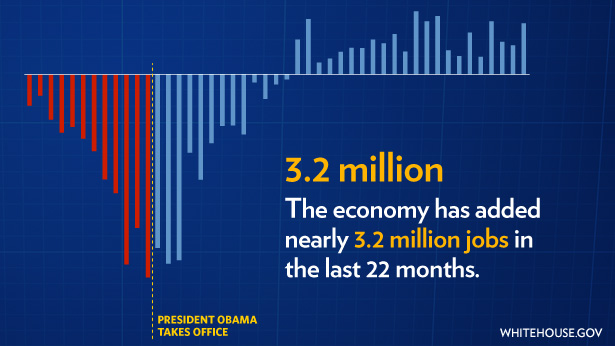
In 2011, American businesses created the most jobs in any year since 2005. In fact, the private sector has added nearly 3.2 million jobs in the last 22 months.
These numbers are proof that we are steadily climbing out of the worst economic downturn since the Great Depression. But we can’t stop now. We must continue to take steps to strengthen and grow our economy.
In his State of the Union address last night, President Obama outlined a Blueprint for an American economy built to last. He laid out a plan to create jobs in the manufacturing and clean energy industries that relies on the skills of American workers. And ee called for a return to American values: hard work, responsibility, and the same rules for everyone, from Wall Street to Main Street.
Learn more about EconomyState of the Union Deep Dive
Posted by on January 25, 2012 at 10:46 AM EDTAmericans who watched an online broadcast of President Obama's 2012 State of the Union address saw something a little different: a side by side display of charts, graphs and other visual representations of why the President's policies are so important for our country and our economy. You can see the slides here, or download them at slideshare
The Blueprint for an America Built to Last
Posted by on January 25, 2012 at 12:19 AM EDTTonight, the President outlined a series of ideas to build an economy that works for everyone, one that will bring about a new era of American manufacturing, and promote homegrown and alternative energy sources.
Taken together, those ideas represent a blueprint for the future.
For decades, economic security for the middle class has been unraveling. Jobs that were once the source of stable livelihoods were shipped overseas. Those at the very top watched their incomes skyrocket, while the majority of Americans were stuck with stagnant salaries and rising costs. And all of this was happening before the worst economic crisis in generations.
What's it going to take to address this crisis?
We need to promote new skills and better education so that all Americans are prepared to compete in a global economy. That's why, tonight, the President said every state should require all students to stay in high school until they earn a diploma or turn 18. That's why the President called for a new partnership between community colleges and businesses to help train and place 2 million skilled workers.
Learn more about , Civil Rights, Defense, Economy, Education, Energy and Environment, Ethics, Fiscal Responsibility, Foreign Policy, Health Care, Immigration, Poverty, Taxes, Technology, Veterans, Working Families, Additional IssuesCelebrating Our Veterans With “Apps for Heroes”
Posted by on January 24, 2012 at 12:14 AM EDTLast Wednesday, we joined Dr. Jill Biden at the Code for America headquarters, a non-profit startup that has attracted dozens of civic-minded software developers spending a year building new products and services – powered, in part, by open government data – to improve the lives of everyday Americans.
Dr. Biden celebrated the convening efforts of Code and 10 apps developed by the private sector to improve the employment prospects for our Nation’s heroes – from apps that help veterans build new skills or a professional network, to a personalized list of open job postings. We observed the results of LinkedIn’s “Veterans Hackday” – two of the 44 apps built over a weekend; a collaboration between two tech companies that had never worked together before – Jibe and KMS Software – to deliver an almost-paperless approach to qualify for eligible tax credits; and the impressive work of a veteran entrepreneur, Fidelis, focused on the military to civilian transition.
We saw these and other “Apps for Heroes” because Code for America made a commitment last August in response to the President’s call to action. We joined Code on this mission and engaged a broader voluntary collaborative of tech firms already active in the employment and training online market. They didn’t ask us for money. Rather, we brainstormed how government data, if released in a people-and-computer-friendly format, could serve as “rocket fuel” for their apps.
And then we went to work.
Inspired by President Obama’s Open Government Initiative and guided by the U.S. National Action Plan, we identified at least three areas where we might open up data that had previously been either in an inaccessible format, organized in a fragmented way, or largely unknown to the developer community:
- Military Service Information: Veterans today collect a form – the DD-214 – that captures their military “resume”; while it can be electronically accessed, the data within the form is protected and in a form that isn’t accessible for a computer to read. Building on the momentum of VA’s initiative, Dr. Levin expanded their “Blue Button” service - which enables a veteran to safely and securely download their personal health data in computer-friendly form - to include a veteran’s service history, training, and credentials. Launched just in the beginning of December, over 60,000 veterans have already downloaded a “Blue Button” file that can be shared with the products and service as they see fit, like the apps for heroes we saw last week.
- Military Skills Translator: The Department of Labor actively supports a non-profit, the O*Net center, to maintain a growing portfolio of tools and data sets that are freely available to developers or anyone for that matter. The problem was that very few of the developers we engaged over the past several months were even aware of this resource. When we showed them what we had they immediately went to work on “translating” military experience into skills that are relevant for their existing products and services.
- Job Postings from Employers Seeking Veterans: President Obama launched the“Veterans Job Bank” last November, which provides access to hundreds of thousands of job postings from employers actively committed to hiring veterans. Built on an open standard, the “JobPosting” schema – endorsed by a coalition of search engines (Google, Microsoft, Yahoo) through the schema.org community – empowers any employer to ensure its job postings are discoverable by the Job Bank. The big idea is that instead of requiring every employer to update a centralized database, we can dynamically “search” for veteran-committed jobs. Its faster, cheaper, and more reliable way to connect employers to talent. The Job Bank itself is accessible at the National Resource Directory and its search widget, built in an effort to support developers has offered an API that delivers search results straight to the app.
Finally, I thought to share the power of Open Innovation @ Internet speed. At a Summer Jobs + event last Tuesday, Twilio CEO, Jeff Lawson challenged the Twilio developer community to build an “App for Heroes.” In about an hour – from concept to go-live – developer Tony Webster built HeroJobs.org, a text messaging app that sends job alerts to veterans every morning based on their preferences, experience, and zip code.
We were humbled and honored that so many innovative firms volunteered their time and effort to incorporate these – and other open government data sets – as an important ingredient for their innovate employment or training support service. Our visit inspired us to push even harder to release government data, celebrate its use, and to engage our veterans directly to ensure they have the support they need in this important life transition.
Aneesh Chopra is U.S. Chief Technology Officer and Peter Levin is Chief Technology Officer and Senior Advisor to the Secretary, Department of Veterans Affairs
Learn more about TechnologyTaking Action for the Middle Class
Posted by on January 23, 2012 at 11:59 AM EDTIn October, President Obama declared that, as a nation, we can’t wait for Congress to resolve their differences and start passing legislation that will jumpstart the economy. Since then, the President himself has taken almost 20 different actions to support the middle class and create jobs.
He's pushed new initiatives, launched new investments, and issued orders to make the government more efficient and effective.
We’ve put together a new video to give you a sense of exactly how much he’s gotten done—even in the face of Congressional gridlock and inaction.
Check out our We Can’t Wait page for more information on all these actions.
Learn more about Economy
- &lsaquo previous
- …
- 3
- 4
- 5
- 6
- 7
- 8
- 9
- 10
- 11
- …
- next &rsaquo
